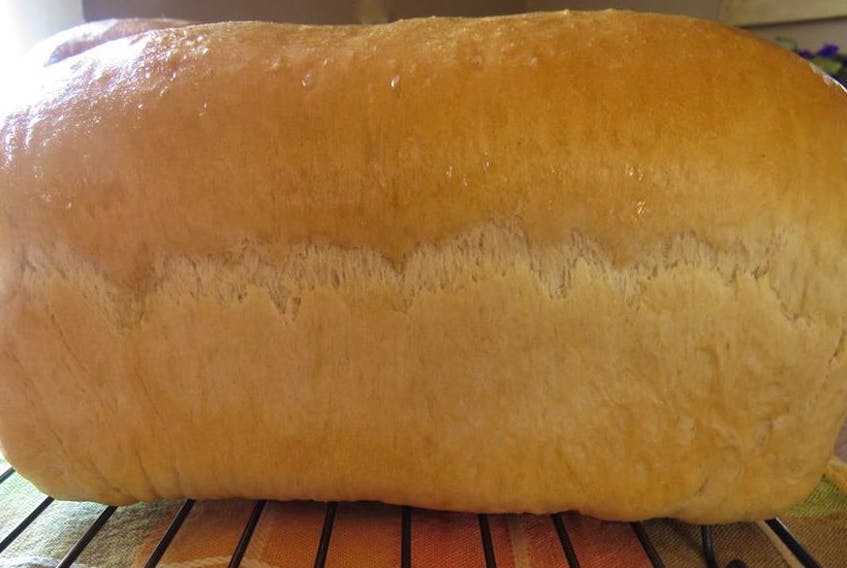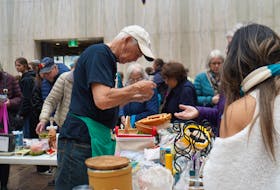
We are still complying with public health instructions to stay home, and I am still baking bread. Judging by my social media feeds, I am not alone.
Generally, we eat breads with at least some whole grain flour in them, but this week, I made two loaves of plain white bread. The picture is shown with today’s column and is posted on Facebook.com/IslandGusto.
The recipe I had lists ingredients for making two, four, six, eight, 10 and 12 loaves. Why would that be? Well, for best results when increasing baking recipes, you don’t necessarily just multiply every ingredient by the number of batches. The author, Janice Murray Gill, did the work to determine the best amounts for making larger batches of this basic white bread.
Some notes about ingredients:
I used reconstituted skim milk powder instead of fluid milk. Skim, low fat or full fat milk would also work.
You can use regular table salt, coarse salt (Kosher, or pickling salt) or sea salt to make bread.
The amount of salt to use can be altered, though you will get best results by adding at least a little salt, unless you are on a strict low-sodium diet.
Besides making bread taste good, salt slows the action of yeast and strengthens the gluten in the flour, making the dough more elastic and resilient. If you decide to omit salt from a bread recipe, you should reduce the amount of yeast and knead the dough for longer to develop the gluten. It also helps to brush the crust with water midway through baking to make the crust crisp.
The recipe just calls for fat. While I used butter, you could use shortening, margarine, lard or vegetable oil. Adding fat to bread dough makes it rise more slowly, creating a finer texture in the bread. Breads made with fat also keep better. To see how the fat in bread affects the texture, think of types at both ends of the spectrum. French bread, which contains no fat, has a coarse holey texture, while Challah (egg bread), which contains about five times the amount of fat in basic white bread, has a fine texture almost like cake.
Basic White Bread Made in Quantity
From Janice Murray Gill: “Canadian Bread Book”. McGraw-Hill Ryerson Limited, Toronto, 1980.
Two Loaves
- 10 mL (2 tsp) yeast
- 375 mL (1½ cups) water
- 125 mL (½ cup) milk
- 15 mL (1 tbsp) sugar
- 10 mL (2 tsp) salt
- 15 mL (1 tbsp) fat
- 1.5 L (6 cups) flour (approx.)
Kneading time: 10 minutes
Four Loaves
- 15 mL (1 tbsp) yeast
- 750 mL (3 cups) water
- 250 mL (1 cup) milk
- 30 mL (1½ tbsp) sugar
- 15 mL (1 tbsp) salt
- 30 mL (2 tbsp) fat
- 3 L (12 cups) flour (approx.)
Kneading time: 10 minutes
Ten Loaves
- 30 mL (2 tbsp) yeast
- 1.75 L (7½ cups) water
- 625 mL (2½ cups) milk
- 75 mL (⅓ cup) sugar
- 30 mL (2 tbsp) salt
- 75 mL (⅓ cup) fat
- 8.5 L (30 cups) flour (approx.)
Kneading time: 15 minutes
Scald milk. Proof yeast in lukewarm water to which 10 mL (2 tsp) of the sugar have been added.
Combine remaining sugar, salt and fat with the hot milk; stir and let stand until lukewarm.
Add the water and yeast mixture.
Stir in about one-third of the flour and beat very well by hand or with mixer. Add additional flour until the dough leaves the sides of the bowl. (If you do not have a bowl large enough, the liquid can be added to the heap of flour on the table. If this method is used there can be no beating of the batter and the kneading time should be increased.)
Add flour until dough is firm and knead on lightly floured board till smooth and elastic. Place in one or more greased bowls; cover and allow to rise till double.
Turn out and divide into desired number of loaves. Let rest, covered, for 10 minutes; shape loaves and place in greased pans. Let rise till doubled; place in preheated 190 C (375 F) oven and bake 40 minutes.
Note: Do not crowd pans in the oven. If baking a large number, rotate twice during baking, first after 15 minutes and again after 30 minutes.
Margaret Prouse, a home economist, can be reached by email at [email protected].









